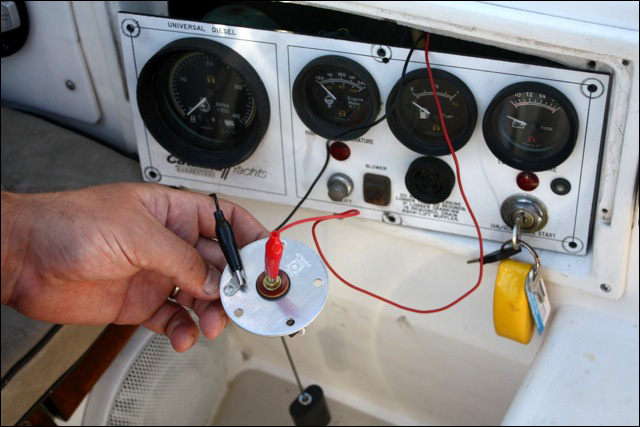 |
| Testing our fuel tank sender float |
It’s a shame that more girls aren’t trained as marine mechanics because, frankly, with the tiny spaces one has to maneuver in to work on a boat, most men, with their big, cumbersome frames, just aren’t built for it.
The job we tackled on Monday, after putting off boat work to celebrate my birthday all weekend, was to figure out why our fuel gauge wasn’t working.
I’d gotten on the Catalina 34 site and Cruiser’s Forum to ask how I could figure out whether the problem was with the fuel gauge on the instrument panel or the sender float in the fuel tank. I got a lot of advice on how to figure this out, along with the guess that we had a bad sender float, and if that was the case, it was more trouble than it was worth to replace it.
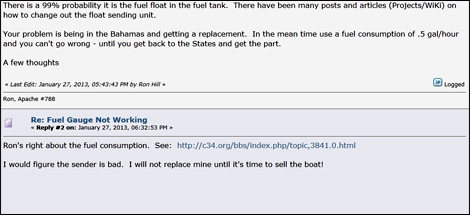 |
| Advice: Replacing the fuel float is more trouble than it is worth |
I relayed this to Ryan and he looked at me like I’d just suggested we live without a fridge because that would be easier than fixing it. “That’s ridiculous!” he said. “It can’t be that hard to fix. Besides, we’ll learn something.” Which is Ryan’s motto for everything we tackle on the boat: “We’ll learn something.” And, granted, this has been true for everything so far. It’s just that it often conflicts with my motto, which is: “Don’t work too hard.”
Since Ryan wasn’t happy to settle for living with a broken fuel gauge, we set to work pulling off the instrument panel in the cockpit to access the wires behind it.
The plan was to test the wire connections and work out which item was broken. And once we worked out it was, indeed, the sender float, the next job was to empty out the back berth (our junk room/food pantry) and take off the panels exposing the tank so we could get to the sender float and the wires running back to our instrument panel.
Now, this is where I come in.
Because, like the time we had to remove the heat exchanger from the engine, and the time we ran wires from our solar panel to our battery monitor through the back of a small hanging locker, we’ve found that Ryan — with his broad, rugby player’s shoulders — just isn’t able to squeeze his upper body into tight spaces and use both hands to tackle an intricate job. I, on the other hand, can shimmy my small frame into just about any space on the boat.
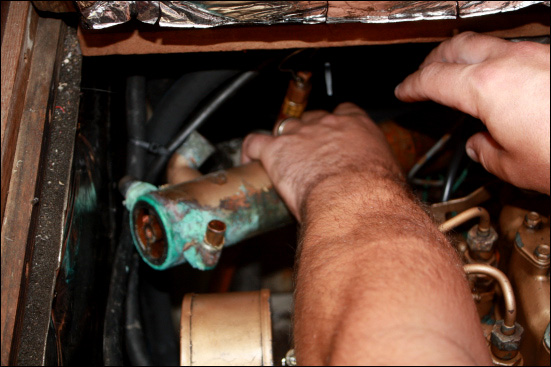 |
| Ryan — with his broad, rugby player’s shoulders — just isn’t able to squeeze his upper body into tight spaces and use both hands to tackle an intricate job. |
For example, removing the heat exchanger required me to hang half upside down in a hole under the back berth so that my shoulders and neck sat on the the hull while my legs and hips were above my head on the berth. In this position, with a flashlight in my mouth, I could use both hands and a screw driver to remove the heat exchanger.
And when we wired the solar panel, though Ryan was able to reach the wires in the back of our hanging locker with one hand, he was unable to
also get his other hand in to crimp the wire connector. I, on the other hand, could shimmy my shoulders almost completely into the locker and
use both hands to do the job.
Accessing the fuel tank, by comparison, was a piece of cake.
I simply squeezed myself into the 3-foot-high space at the foot of the back berth, under the cockpit, where our fuel tank sits behind a removable panel. With a flashlight in my mouth, and my arms squeezed into the space above the tank, I removed the screws on the sender float. The only problem was that, being inexperienced at mechanical work, I hadn’t yet worked out that the five screws around the edge of the fitting held the gasket in place, while the center screw held the float to the fitting… and also kept it from falling into the tank.
I worked this out quickly, though, when I unscrewed the center nut and then shouted, “Noooooo!” as the sender float slipped away from the gasket and kerplunked into the tank. I looked at Ryan sheepishly, and could tell he was trying really hard not to say, “That was really stupid.” Luckily, I saved the day with some electrical wire and a fish hook. Though our fish hook has yet to snag us a fish, it’s now revered for having retrieved our sender float from the fuel tank.
And once we had the sender float in our hands, we could wire it up directly to the instrument panel and indeed confirm that when we moved the float up and down, the needle on the instrument panel didn’t move. Which meant the sender float was definitely the problem.
Within an hour, though, Ryan had returned from a nearby marine store in Nassau with a new sender float. So we wired it up to our instrument
panel and voila! The needle moved!
Now all I had to do was crawl back down to the fuel tank and install the new float without dropping it in the tank this time.
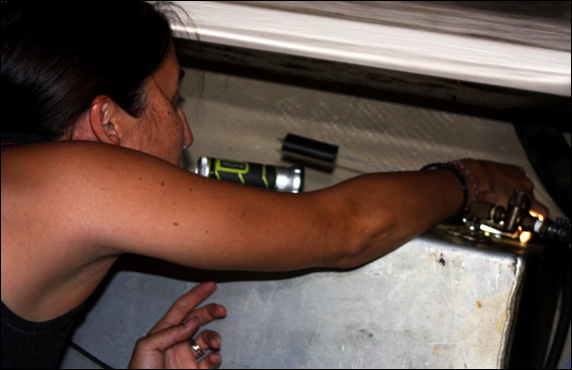 |
| Installing the new fuel tank sender float |
Note to self: Don’t remove the center screw. If I do say so myself, my installation job was much quicker and more professional than my removal job. Which I think means I’m improving my skills. And thanks to having small shoulders, I only got a small crick in my neck and no major bruises.
I’m trying to take more of an interest in the mechanical workings of our boat, even though I feel that some things are beyond my comprehension. Like AC and DC electrics. But then again, Ryan has no more training in this area than I do, so it would be unfair to assume he should do all the mechanical work just because he’s a man.
I’d be wiling to venture, though, if more women were trained as marine mechanics, the male mechanics of the world would find themselves up against some tough competition. We ladies are just better built for it!
This article was published on February 5, 2013 in Tasha Hacker’s blog: www.TurfToSurf.com
About Tasha Hacker
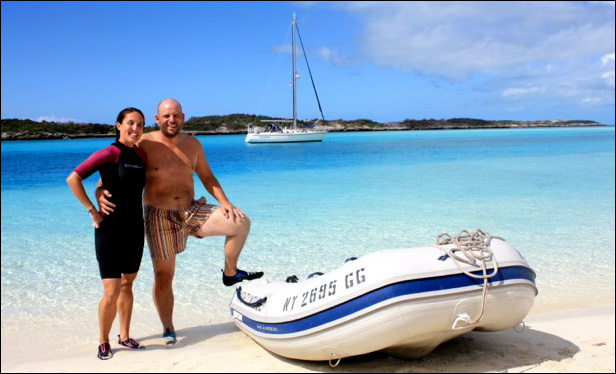
Tasha is a Traveler who became an English Teacher and then a School Owner but really wanted to be a Ski Bum and instead became a Sailor.
When her husband Ryan blurted out in 2005, “It’s my dream to sail around the world,” her response was, “That’s ridiculous. Who lives on a boat?!” Which resulted in them not speaking.
But the idea festered. So in October 2012, Tasha found herself sailing out of New York City with Ryan and their two cats aboard a Catalina 34 sailboat with an appetite for adventure and a blog url: www.TurfToSurf.com
- Your disability is your opportunity, by Teresa Carey
- How we learn: All posts


Great job . . . and I’m sure you’ll catch on to the DC side of things, too. I did all the electrical on our boat, just because. We never did have a problem with the AC side of things, but we made a pact that if we did, we were hiring an electrician — AC can kill and neither one of us was comfortable dealing with it.
And yeah, I’ve always thought that at least one person on board should be a contortionist!
While I didn’t do much electrical stuff per se on Tackless II, I did understand it, after reading up about it. Back then I was enamored of the 12 Volt doctor’s Alternator Book, which for some reason is very hard to find. But, bu golly, after reading it I understood how alternators work! Today’s version would probably be Nigel Calder, although he is sometimes a little too comprehensive for someone trying to get the basic principles down. Understanding really contributes to diagnoses when both of you can contribute to analyzing a problem.
What I did do was most of the electronics hook ups, which requires small hands and a logical mind…”let’s see the output from here goes to the input there, etc” and I did do 12 volt electrical stuff on my own boat Whisper. I second the counsel to hire professionals for 110v issues!
Good job sailing sista! Awesome posting about your experience. We BOTH attended Marina Diesel School because we felt it would be important for us BOTH to learn the material as nether of us had much knowledge or experience in the marine diesel world.
~~_/)~~
Sabrina
s/v Honey Ryder Caliber 40 LRC
http://www.wildcatsailorgirl.blogspot.com/